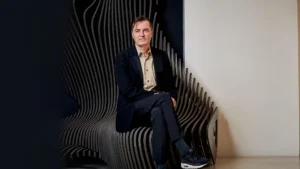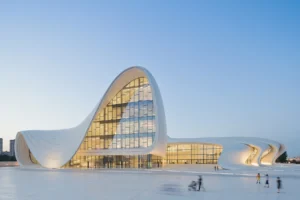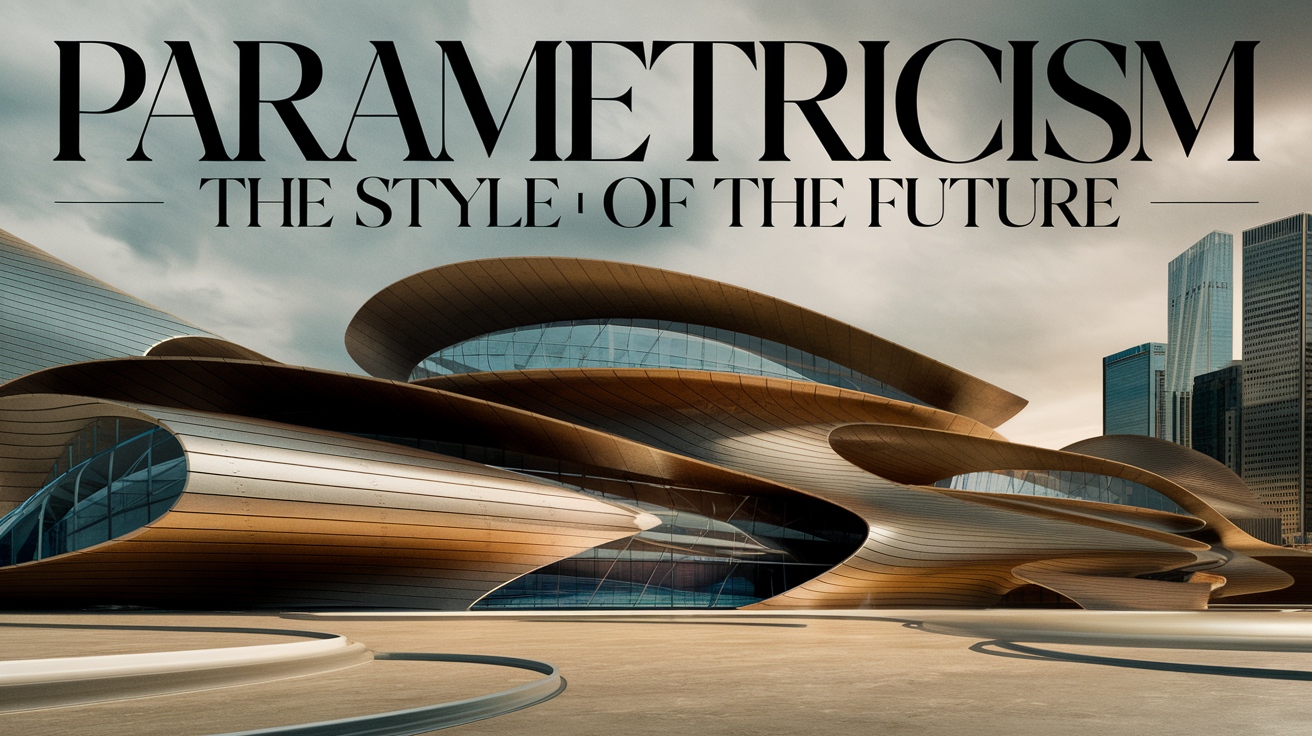Architecture has always been a field of evolution—pushing boundaries, redefining aesthetics, and optimizing functionality. But what if buildings could adapt, respond, and evolve based on their environment and purpose? This is where parametricism in architecture emerges as a revolutionary force.
This architectural style merges computer-aided design (CAD), computational algorithms, and advanced modeling techniques to create structures that are fluid, organic, and highly optimized. Instead of rigid traditional design methods, parametric architecture enables designers to develop complex geometries that reflect nature’s adaptability.
But what exactly is parametricism, and why is it considered the next phase of architectural evolution? Let’s break it down.
What is Parametric Design?

Before diving into parametricism in architecture, it’s essential to understand parametric design—the foundational concept behind this movement.
Parametric design is a rule-based design process where architects use mathematical algorithms and constraints to define building forms. Instead of manually drawing each element, parameters (such as material strength, environmental conditions, and structural load) are set within a computer-aided design (CAD) software, which then generates multiple variations based on these inputs.
This approach is closely related to generative design, where AI-driven tools explore a vast range of design possibilities based on pre-set criteria.
What is Parametricism in Architecture?
Parametricism is more than just a design method—it’s a philosophy and movement in architecture. The term was coined by Patrik Schumacher, principal Architect at Zaha Hadid Architects, in 2008.
Parametricism is an advanced architectural style that uses computational design techniques to generate fluid, organic, and highly adaptable structures. It relies on parametric equation and parametric modeling to define complex building geometries, making designs more responsive and optimized than traditional architectural methods.

parametric design principles include:
- Fluidity and Continuity – No straight lines; instead, everything flows smoothly.
- Complex Geometries – Buildings look organic, almost as if they were sculpted by nature.
- Algorithmic Logic – Structures are generated using computer algorithms rather than manual sketches.
- Adaptability – Designs evolve based on functional and environmental constraints.
From airports and museums to skyscrapers and stadiums, parametricism in architecture is shaping the future.
Zaha Hadid: The Queen of Curves

No discussion on parametricism is complete without mentioning Zaha Hadid, the visionary who revolutionized modern architectural design.
Born in Baghdad, Iraq, in 1950, Zaha Hadid studied mathematics before pursuing architecture at the Architectural Association School of Architecture in London. Her early work was influenced by deconstructivism, but she later embraced computational techniques to create her signature fluid, futuristic designs.
Her firm, Zaha Hadid Architects (ZHA), pioneered parametric architecture, using computer-aided design and algorithmic modelling to craft some of the most iconic buildings of the 21st century.
Some of her most famous works include:
- Heydar Aliyev Center (Baku, Azerbaijan)
- Guangzhou Opera House (China)
- London Aquatics Centre (UK)
Hadid’s radical, free-flowing designs earned her global recognition, making her the first woman to win the Pritzker Architecture Prize in 2004. She passed away in 2016, but her legacy in parametric design continues to inspire architects worldwide.
Patrik Schumacher: The Mind Behind Parametricism

Born in Bonn, Germany (1961), Patrik Schumacher studied architecture at the University of Stuttgart and later at London’s Architectural Association. Joining Zaha Hadid Architects in 1988, he became instrumental in shaping parametric architecture.
In 2008, he coined “parametricism”, defining it as the successor to modernism. As ZHA’s principal after Hadid passed, he mastered AI-driven design, parametric urbanism, and digital fabrication. His bold, market-driven architectural theories often spark debate, but his influence on computational design and future architecture is undeniable.
Key Contributions:
- Coined “Parametricism” – Established as a new architectural paradigm.
- Academic Influence – Teaches at leading universities, shaping future architects.
- Digital Design Advocate – Pushes boundaries of algorithm-driven architecture.
- Leader at Zaha Hadid Architects – Continues Hadid’s legacy while innovating.
- Visionary in AI & Urbanism – Advocates parametric solutions for future cities.
Parametricism 1.0 (2009–2014):
Introduced by Patrik Schumacher in 2008, Parametricism 1.0 refers to the first phase of parametric architecture, where designers used algorithms and computational models to generate complex, free-flowing forms. It is marked as the beginning of a radical shift in architectural design. It was primarily an aesthetic movement, focusing on fluid geometries, organic shapes, and futuristic designs, often without deep consideration of functionality or sustainability
Characteristics of Parametricism 1.0:
- Algorithm-Driven Design – Architects relied on computational algorithms to generate complex forms, enabling greater design flexibility.
- Use of Parametric Tools – Software like Grasshopper for Rhino, Autodesk Maya, and Generative Components allowed designers to create adaptive and organic structures.
- Aesthetic Focus – The early phase was heavily form-driven, leading to sculptural and futuristic designs without always considering functionality.
- Digital Fabrication – CNC machining, 3D printing, and robotic construction were widely explored to bring intricate, non-repetitive designs to life.
Parametricism 2.0 (2015–Present):
Parametricism 2.0 is the evolved version of the original movement, where design complexity is balanced with functionality, sustainability, and real-world integration. This phase emphasizes data-driven design, environmental adaptability, and AI-powered optimizations to create efficient, responsive, and human-centric architecture.
Characteristics of Parametricism 2.0:
- Context-Aware Design – Instead of just creating complex forms, architects now use parametricism to solve real-world problems, such as urban congestion, climate adaptation, and material efficiency.
- Integration of AI & Machine Learning – Modern parametricism leverages real-time data analysis, generative AI, and predictive modeling to optimize structural efficiency and resource use.
- Smart Cities & Urban Planning – Parametric techniques are applied at city-wide scales, improving traffic flow, public spaces, and energy distribution.
- Sustainable Architecture – Buildings are now designed to adapt to environmental conditions, reducing energy consumption and improving thermal performance.
Criticism of Parametricism
While parametricism in architecture has revolutionized interior design, it has also faced significant criticism from architects, urban planners, and theorists.
1. Overemphasis on Form Over Function
One of the biggest criticisms is that parametricism often focuses more on intricate, visually appealing forms rather than their practical usability. Many parametric buildings feature dramatic, organic shapes that are difficult to construct, maintain, or use efficiently.
Criticism: Some projects, while stunning, have resulted in poor interior layouts, inefficient space utilization, or high maintenance costs due to their unconventional geometries.
2. High Cost & Complexity
The use of advanced computational tools, specialized materials, and non-standard fabrication techniques makes parametric architecture expensive and time-consuming.
Criticism: Many construction firms struggle with the technical expertise and financial resources required for customized parametric structures, making them less feasible for widespread adoption.
3. Lack of Human-Centric Design
Some critics argue that parametric designs often lack human scale and comfort. The focus on mathematical algorithms and computational aesthetics sometimes leads to cold, impersonal spaces rather than environments designed with human experience in mind.
Criticism: A building that looks futuristic does not necessarily enhance livability, usability, or community well-being.
4. Environmental Impact Concerns
Although Parametricism 2.0 emphasizes sustainability, many early parametric projects used energy-intensive materials, excessive glass facades, and inefficient designs that contributed to high energy consumption.
Criticism: Some argue that parametricism increases material waste due to the complex forms requiring custom fabrication, which can be less sustainable than traditional architecture.
5. Exclusion from Traditional Architectural Theory
Many traditionalists criticize parametricism for being too detached from architectural history. Unlike movements like Modernism or Postmodernism, which had clear philosophical and cultural roots, parametricism is often seen as a purely technological shift, lacking a deeper social or artistic foundation.
Criticism: Some believe parametricism is more of a “style” than a true architectural movement, while others argue it lacks a universal application across all building types.
Case Studies: Parametricism in Action
1. Galaxy SOHO – Beijing, China

Project Overview
- Architect: Zaha Hadid Architects
- Completed: 2012
- Function: Mixed-use (offices, retail, and entertainment)
- Design Concept: Inspired by natural landscapes with fluid, interconnected spaces
How Parametricism Was Used
Galaxy SOHO is a prime example of parametric architecture, designed using complex algorithms to generate seamless, organic forms.
Fluidity & Connectivity – The building consists of four continuous, flowing volumes that merge into each other, eliminating sharp corners and traditional divisions. The parametric model allowed designers to optimize circulation, daylight penetration, and spatial connectivity.
Digital Fabrication – The project heavily relied on computer-aided design (CAD) and Building Information Modeling (BIM) to precisely fabricate and assemble its complex curved façades.
Sustainable Considerations – While the design is striking, critics argue that the excessive use of glass and curved surfaces increased cooling loads due to heat gain, a challenge often seen in early parametric buildings.
Why It’s Important
Galaxy SOHO challenged traditional urban design in China, introducing a futuristic approach to mixed-use development, redefining how commercial spaces interact with public environments.
2. Heydar Aliyev Centre – Baku, Azerbaijan

Project Overview
- Architect: Zaha Hadid Architects
- Completed: 2012
- Function: Cultural center
- Design Concept: A flowing, wave-like structure symbolizing fluidity and progress
How Parametricism Was Used
The Heydar Aliyev Centre is one of the most recognized examples of parametric architecture, designed with advanced computational tools to create freeform surfaces and organic geometries.
Algorithmic Design – The structure’s sweeping curves and seamless transitions were generated through parametric modeling, ensuring a fluid, continuous aesthetic without rigid boundaries.
Structural Engineering Challenges – The absence of traditional columns or sharp angles required engineers to develop a unique load-distribution system, optimized through computational simulations.
Material Innovation – The building’s skin-like envelope was made using custom-fabricated panels, each uniquely shaped and cut based on precise digital models.
Why It’s Important
The Heydar Aliyev Centre redefined cultural architecture, proving that parametricism could break free from rectilinear constraints, creating a building that feels alive and dynamic. It became an instant landmark, symbolizing Azerbaijan’s modern identity and progress.
3. Jockey Club Innovation Tower – Hong Kong

Project Overview
- Architect: Zaha Hadid Architects
- Completed: 2014
- Function: Design school for the Hong Kong Polytechnic University
- Design Concept: A futuristic tower with flowing, layered geometries reflecting movement and innovation
How Parametricism Was Used
The Jockey Club Innovation Tower was designed using parametric modeling software to create complex, layered forms that respond to functionality, urban context, and environmental conditions.
Aerodynamic Form – The sweeping, elongated structure was generated through computational simulations, allowing it to blend with its surroundings while optimizing airflow.
Adaptive Interiors – The design focused on flexibility and fluidity, incorporating non-linear circulation paths, open collaboration spaces, and dynamic interior transitions.
Integration with Urban Landscape – The building’s base appears to melt into the street, eliminating harsh separations between exterior and interior spaces, a signature feature of parametric design thinking.
Why It’s Important
This project showcases the potential of parametricism in architecture, proving that academic institutions don’t have to follow conventional, box-like designs. Instead, parametric design enables adaptive learning environments that inspire creativity and innovation.
Conclusion
So, is parametricism in architecture the best way to build the future?
The answer lies in its ability to blend innovation, efficiency, and sustainability. With computer-aided design (CAD), computational modelling, and AI-driven simulations, parametricism enables architects to create highly optimized, futuristic structures.
While it faces challenges in practicality and cost, advancements in digital construction technologies are making parametric architecture more accessible and feasible.
In the end, Zaha Hadid’s vision and Patrik Schumacher’s theory have set the foundation for a new architectural paradigm—one where buildings aren’t just designed but evolve dynamically with the world around them.
The future of architecture isn’t rigid or geometric—it’s fluid, adaptive, and driven by data.
Frequently Asked Questions:
- What does parametricism in architecture mean?
It refers to algorithm-driven design that creates complex, adaptable forms based on predefined parameters. - Which architect is known for parametricism?
Patrik Schumacher, a principal at Zaha Hadid Architects, coined and promoted parametricism. - What are the principles of parametric design?
It focuses on algorithmic modeling, adaptability, fluid forms, and continuous variation in design. - 4. What is the difference between parametricism and deconstructivism?
Parametricism emphasizes smooth, flowing forms, while deconstructivism focuses on fragmentation and asymmetry.
